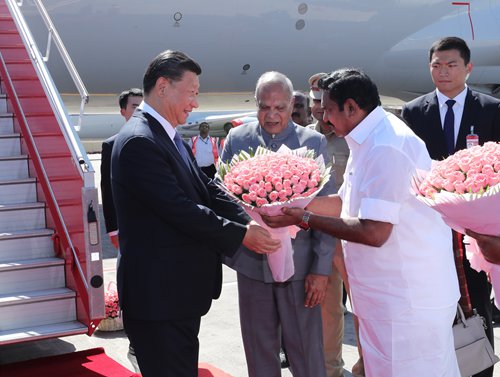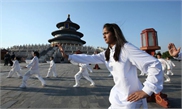
Indian officials welcome Chinese President Xi Jinping upon his arrival in Chennai, India, on Friday afternoon for the second informal summit with Indian Prime Minister Narendra Modi. Photo: Xinhua
Chinese President Xi Jinping arrived in Chennai, India, on Friday afternoon for the second informal meeting with Indian Prime Minister Narendra Modi, which is highly anticipated to continue the spirit of the first informal summit in Wuhan last year and make joint efforts to revive the Asian civilizations.
Xi was treated to a local Tamil traditional dance on the airport runway.
Modi tweeted on Friday in Chinese that "It is gladdening that Tamil Nadu will host President Xi Jinping. May this Informal Summit further strengthen ties between India and China."
Chinese and Indian observers noted that both are developing countries and emerging economies, and that China-India relations have surpassed the traditional bilateral scope and are exerting regional and global influence.
Chinese national flags could be seen hanging outside the Chennai airport to welcome Xi's visit.
Around 2,000 students of a school in Chennai, capital of the Indian state of Tamil Nadu, formed the name of President Xi next to big yellow words "hearty welcome" painted on the ground, welcoming him to India, according to a video published by New Delhi-based multimedia news agency Asian News International on Thursday.
After Xi landed in Chennai, Modi hosted Xi at the famous world heritage site of the Shore temple complex in Mamallapuram, an ancient coastal town in southeastern India, where they held a meeting.
On Saturday, both leaders will have a one-on-one meeting followed by delegation-level talks, and the Chinese president will leave for Nepal from Chennai, the Mint report said.

Reporters gather at the gate of the world heritage temple complex in Mamallapuram, an ancient coastal town in southeastern India, where Chinese President Xi Jinping and Indian Prime Minister Narendra Modi will hold a meeting on Friday. Photo: Cao Siqi/GT
Meeting 2.0
Indian analysts pointed out that since it is an informal summit, no agreements will be signed, no joint statement issued, and no press conference will be held.
It implies that the two leaders are at ease during informal summits, which means the leaders will get enough space for one-on-one discussions to get to know and understand each other better, said Bali Ram Deepak, director of the Centre for Chinese and Southeast Asian Studies at Jawaharlal Nehru University in New Delhi.
Last year, in the first informal summit in Wuhan, capital of Central China's Hubei Province, Xi and Modi spent almost 10 hours covering seven events, which included four one-on-one meetings, a stroll and tea-tasting along the lakeside, boat ride, and museum tour.
Deepak believes that the informal summit does not mean that the meeting is directionless. Instead, it is helpful in establishing the strategic communication between the leaders, build consensus on certain issues and give an overall direction to the bilateral relations.
During the Wuhan summit, the two leaders agreed that the two countries will continue to maintain strategic communication in various forms and to advance all-round cooperation, strengthen the China-India Closer Developmental Partnership and strengthen dialogue on political issues, security and other areas.
Both sides also agreed to properly manage and control their differences. They agreed to use the Special Representatives' Meeting on the Boundary Question to seek a fair, reasonable and mutually acceptable settlement.
All issues, including bilateral, regional, and global issues of common concern would be discussed during the summit, Deepak said, including counter-terrorism strategies and issues related to trade and investment, like India's concerns about the trade deficit and India seeking greater access in China for its highly competitive pharmaceutical and informational technology products.
Hu Shisheng, director of the Institute of South and Southeast Asian and Oceania Studies at the China Institutes of Contemporary International Relations, said the leaders' meetings could inject strong momentum on enhancing strategic mutual trust between the two countries. Based on this, China-India economic and trade cooperation is expected to expand.
By expanding cooperation in traditional and emerging fields such as manufacturing, pharmaceuticals, infrastructure construction, big data, and artificial intelligence, bilateral economic and trade relations will be healthier and more comprehensive, Hu said.
Partners instead of threats
The second informal summit is taking place amid the South Asian turmoil and frictions between China and the US.
Chinese analysts pointed out that India believes that in the wake of enormous pressure from the US, China will definitely seek good relations with neighboring countries, including India. India may wish to take this opportunity to fulfill some of its diplomatic demands and urge China to support some of its domestic and foreign policies to further enhance India's international status and boost national morale amid the economic downturn.
New Delhi should know that the Trump administration's policies toward India are not consistent. The US attempt to draw India closer is aimed at keeping the US dominance in the Asia-Pacific region and containing China, said Hu Zhiyong, a research fellow at the Institute of International Relations of the Shanghai Academy of Social Sciences.
Looking back, some of the remaining issues will interfere in China-India relations from time to time. But the two sides are willing to communicate, indicating that China and India should recognize each other as partners and opportunities, rather than threats or challenges, said Li Li, director of Center for South Asian Studies, Tsinghua University, adding that the differences should not and will not disturb the cooperation between the two countries.
Civilizational linkages
Indian scholars believe that the selection of Mamallapuram also reinforces the civilizational linkages between India and China.
In Wuhan, the two leaders also directed the setting up of a High-Level Mechanism on Cultural and People-to-People Exchanges led by the foreign ministers of both countries. The mechanism has already held two meetings and has identified 10 areas of cooperation, many of which will take center stage next year as China and India celebrate the 70th anniversary of diplomatic relations.
Wuhan has long been renowned as a center for the arts (especially poetry) and its history dates back 3,500 years. It was the location of the Wuchang Uprising, which led to the downfall of the Qing Dynasty.
Mamallapuram was a flourishing seaport during the 6th and 7th centuries under Pallava kings who had established cultural, commercial, defense and, above all, trade ties with China. In the year 527 AD, Bodhidharma, the third son of a Pallava king, reached China and became the 28th Patriarch of Buddhism. Historian K A Nilakanta wrote about Bodhidharma becoming an icon of Chinese civilization.
"I believe this is the message both leaders would like to give to the people of their countries as well as the region that the dialogue of the civilizations rather than Huttington's thesis of the clash of civilizations should be instrumental in building bridges between the people," Deepak said.
By showcasing this historic site, Modi will remind Xi that not only is India an ancient civilization like China, but that both countries were the foremost economies of the world until 1700, which then lost their pre-eminence in the world due to the advent of the Industrial Revolution in the West, said Gautam Bambawale, a former Indian Ambassador to Bhutan, Pakistan and China.
By doing so, Modi will also show to Xi that China is not only regaining its position of global pre-eminence, but so, too, is India. Two re-emerging nations such as India and China may not see eye to eye on each and every issue, but the larger trend of cooperation between the two Asian neighbors will continue to constitute the mainstream of the bilateral relationship, even as each country continues its steady rise in global politics and economics, Bambawale said.



